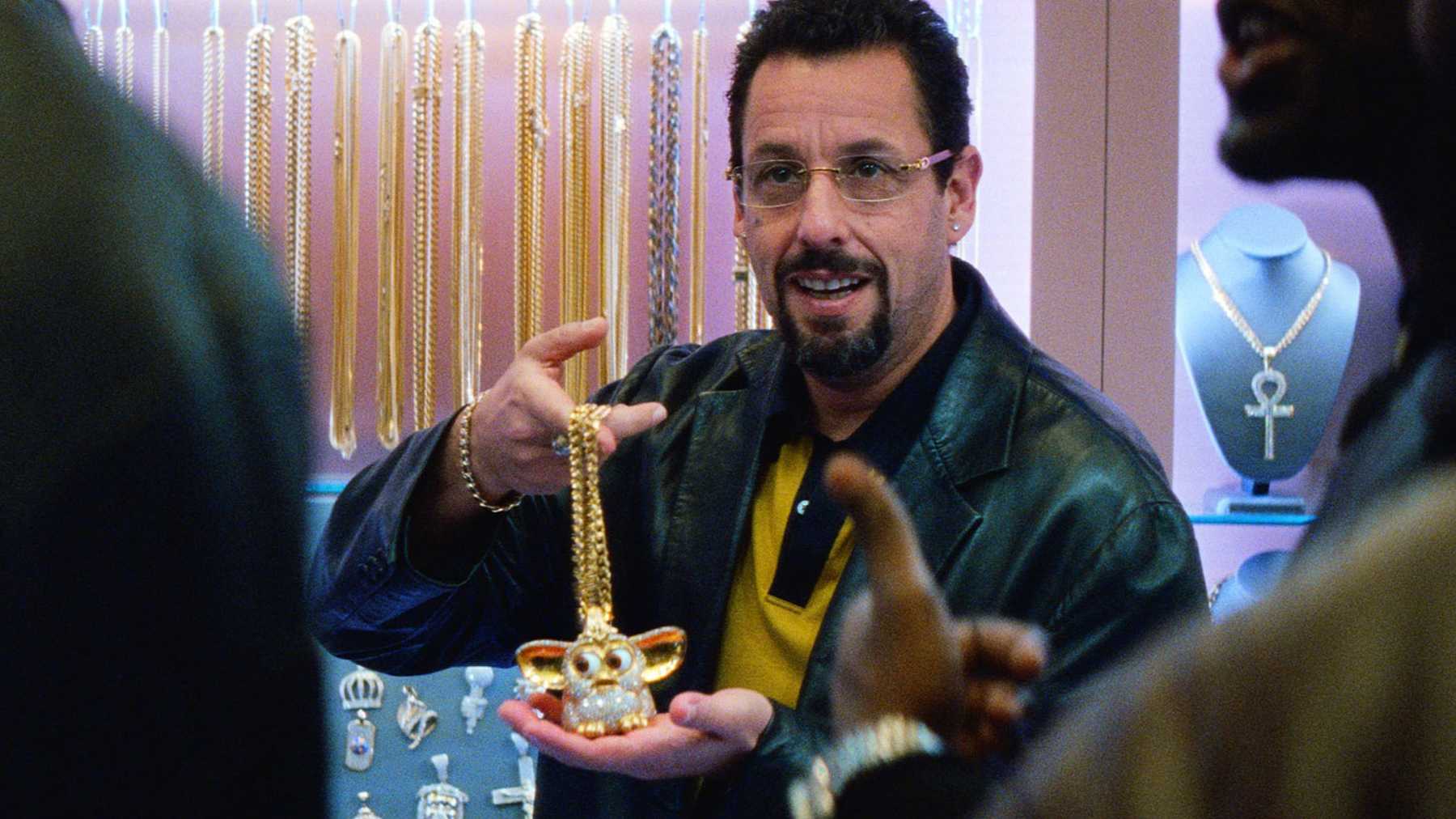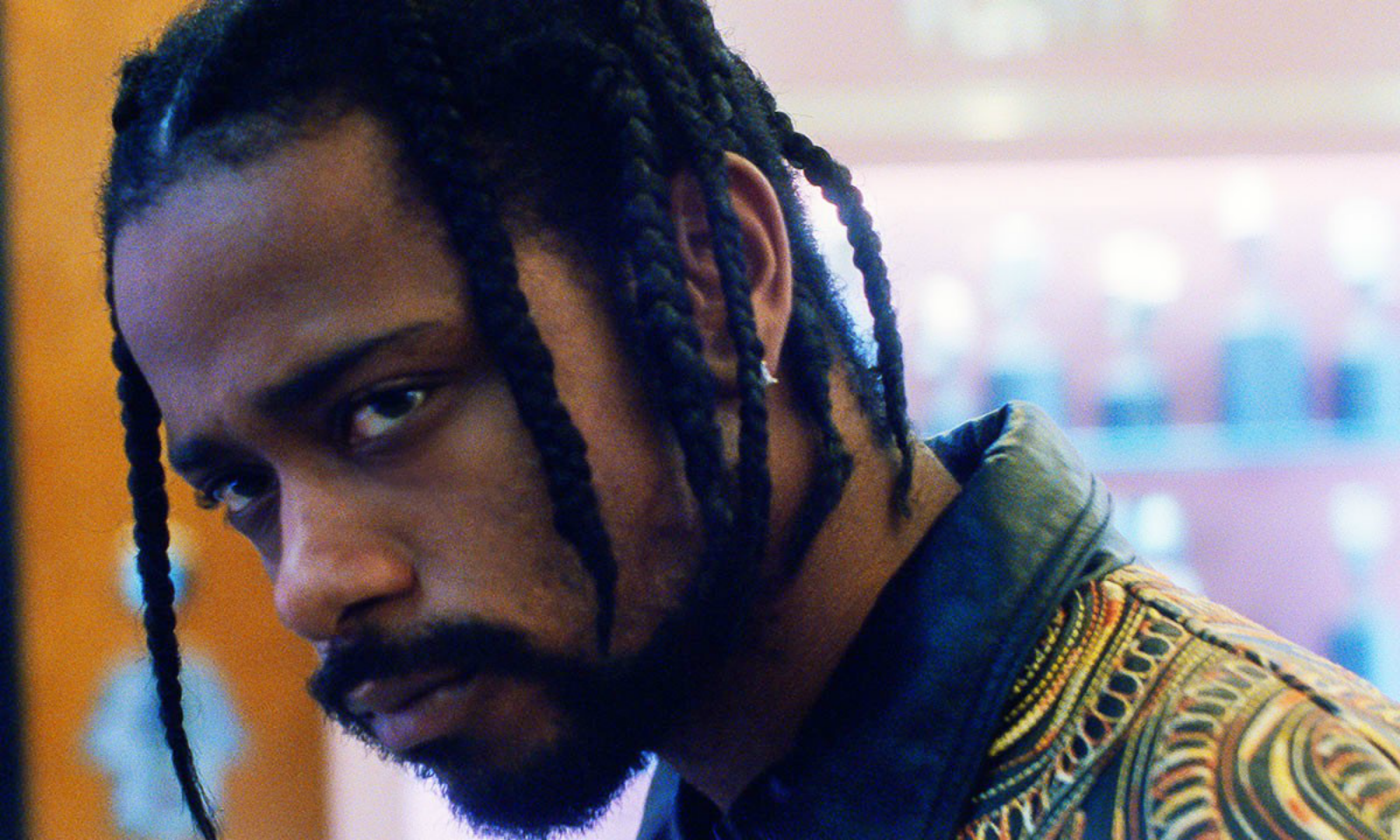When they were children, brothers Josh and Benny Safdie made a fake documentary about a man who smokes himself to death whilst watching a Knicks game. The man was played by Josh (then seven years old) using cigarettes taken from their father, while Benny filmed. The cigarettes got larger and larger throughout the film, until Josh was smoking a huge baton of rolled up toilet paper. “That was one of the first times I smoked a cigarette,” Josh says.
The film was intended as anti-smoking propaganda for their father, who smoked as compulsively as the boys filmed and, though it didn’t succeed in getting him to quit, the fake PSA did contain elements that have since become trademarks of their work, blurring the line between documentary and fiction and betraying a fascination with the absurdity of real life.
Their father was also the inspiration for the Safdies’ latest film, Uncut Gems, which has been described, for good reason, as a heart attack. If their previous outing, Good Time — a frenetic crime thriller starring Robert Pattinson and Benny Safdie — struck you as too sedate, you’ll be pleased to learn that Uncut Gems is one aneurysm closer to full blackout.

For years, Safdie senior worked among the colourful characters of New York’s Diamond District — a one-mile stretch along 47th street, housing the nation’s highest concentration of both gemstones and firearms. “Everyone knows each other,” Benny says, “but the Lords, the Kings, are the jewellers. They have a public presence because they own property and associate with celebrities.” The Safdies’ father worked as a runner for a dealer called Howard, whose bizarre and often dangerous exploits provided the adrenaline highs he obviously craved and an endless stream of pulpy anecdotes to take home to his story-obsessed sons. Ten years after writing their first draft, these stories have reached the big screen.
Cast brilliantly against type, Adam Sandler plays Howard Ratner, a manic dealer specialising, as the name of his shop suggests, in uncut gems: stones that have not been sloughed of their original texture and roughness. Much like Howard, these stones are an acquired taste. He relies on connected middlemen to drum up interest for his exotic finds, such as Demany (played by Lakeith Stanfield), who throws him into the path of NBA star Kevin Garnett (playing himself).
When Howard gets his hands on a rare black opal, supposed to be worth millions, he can’t resist showing it off to Kevin, who promptly falls in love with the unusual stone and asks, in the offhand way of someone used to getting what they want, to borrow it. Cajoled by Demany, against his better judgement, Howard hands over his prize to Garnett. As collateral, the jeweller keeps the player’s championship ring, which he promptly pawns, triggering a chain of increasingly high stakes bets, culminating in a Game 7 match so urgent and heart-rending that even the biggest basketball neophyte will be gripped.
“You spend the entirety of the film with a meter going off inside your head,” Josh says. “The pin is jumping up and down, constantly, because Howard’s behaviour is aspirational — it’s upwardly striving, it’s romantic — but he’s a gambler, a nauseating optimist, and the things he’s doing are ultimately moronic. So you root for him despite your common sense.” As with Connie, Robert Pattinson’s character in Good Time, Howard is flawed and abrasive, engaged in some pretty unsavoury activities, yet, as Josh observes, we root for him despite himself. More than that, we care for him deeply.
The casting of Howard was a difficult proposition. “He’s a larger than life character,” Benny points out, “so it needed a star”. Whereas in earlier films, the brothers have veered to the very furthest edges of what constitutes fiction, using non-actors (or, as the Safdies’ refer to them, First Time Professionals), filming without permits and often borrowing directly from real life, Uncut Gems required them to scale up in terms of both production and star power. “Previously we only wanted to use real people because we thought that was the only way to access real life. But for this film, that all changed because we needed the casting to align with the subject matter.”
From the very first draft, they knew they wanted Sandler. “He has this ability to ground absurd situations in reality, and you always care about him,” Josh says. The brothers had grown up watching Sandler’s movies and were particularly obsessed with his records, which they still quote back to him like excited fans. “We went out to Sandler in 2010. I can’t find the initial offer but it was a no,” Benny assures me. “Then we made a documentary called Lenny Cooke and, in doing research about the diamond industry, we met a young woman named Arielle Holmes and ended up making a movie about her, called Heaven Knows What. Then, we tried to parlay the modicum of success we got from those two combined, in order to double down for Sandler again. We got a polite pass and went down the line with some other actors but it didn’t pan out. Then finally, after Good Time came out, we finally made contact with Sandler himself (whom they now affectionately call Sandman) and it came together.”
If all this talk of doubling down and parlaying doesn’t make your heart do a neat flip of anxiety, it’s because you haven’t yet seen the film and don’t know what it is to watch Howard glibly turn his whole life into collateral. “He has the air of a conquistador, which is what you have to be as a filmmaker,” Benny says drily. Indeed, the parallels between Howard’s incessant gambling and the punts of the independent filmmaker are certainly not lost on the Safdies. “It took a decade of being almost drunkenly optimistic to get this film made, ignoring those who saw no value in it, parlaying every project onto the next. Conscious that if one movie didn’t work, we might never be able to do it again.”
When Sandler finally got his hands on the script — which had come a long way since the Safdies’ first draft in 2010 — he was concerned by two things. Firstly, that the character was such a tour de force, and secondly, that he was doing things so far removed from the way that Sandler lives his own life. Namely, Howard’s frustration with domestic life and the stasis of suburbia. A happily married man and delighted father, Sandler found it hard to care for a character who so wantonly discarded family in favour of fleeting pleasures and was baffled by the Safdies’ adoration for the grasping, unprincipled jeweller.
Still, the writing brimmed with electricity and Sandler’s wife urged him to take the risk. What was important to him, was that Howard’s character be tempered by a constant awareness of his activities in relation to his family and concern for their safety and wellbeing. Sandler’s mantra was that, “while Howard may do bad things, he’s not a bad person.”
In a particularly memorable scene, Howard’s wife, played by Idina Menzel (another piece of inspired left-field casting) delivers a lacerating speech, verbalising everything we’ve been feeling about the embattled jeweller but hadn’t yet had the heart to tell him. Despite their impending divorce, the couple have just eaten a beautiful Passover Seder, surrounded by friends and family, and Howard, on the outs with his mistress (an explosive Julia Fox), is feeling sentimental. As they stand in a cramped antechamber, he looks deep into his wife’s eyes and wonders if they’re making a mistake by separating. Her look of derision is acidic, but she holds his gaze for a moment, allowing him to hope, before assuring him that he is, “the most annoying person [she has] ever met,” and leaving the room.
The walls are closing in upon the doomed Howard. The security door to his shop keeps getting jammed, trapping first Kevin Garnett’s posse and later more dangerous occupants inside its clear, impenetrable walls. Having absconded from his huge family home to his bolthole in the city, he then ends up shunted to a makeshift bed in the back of his cluttered office after another epic fight with his mistress. Every space feels claustrophobic, as if the oxygen is running out. Like a caged tiger Howard comes up against the borders of the Diamond District’s one-mile radius with increasing force, until it seems inevitable that he will be crushed. “As we were shooting, we would remind Sandler, ‘Remember what happens at the end of this movie’,” Josh says. To keep him present.” I won’t ruin that heart-stopping moment for you but I will say that there is something of the mythic hero in Howard’s rise and fall — a Promethean tendency to overreach. Much like the Safdies themselves, he is a conquistador surging forward, compelled by the promise of more.

With the casting of Sandler and the involvement of A24 and Netflix, plus Martin Scorsese on board as Executive Producer, Uncut Gems was shaping up to be a substantial operation, quantum leaps larger than the Safdies’ previous productions. “Going into this, we felt the weight of it,” Benny says. “A big crew, unions.” Whereas their previous movies achieved near-miraculous veracity, thanks to the brothers’ preference for non-actors and naturalistic dialogue (written by Josh, together with frequent collaborator Ronald Bronstein), Uncut Gems presented a challenge as to what a larger scale would do to their methods.
“The thing is,” Benny says, “when you’re on the street in New York City, you can’t ignore the fact that you’re shooting with Adam Sandler, but what you can do is leave the streets open and act like it’s no big deal. Like, you can walk through our set, just don’t bother us.” The Safdies found that their laid-back approach swiftly caught on and they proceeded to shoot largely unbothered, in the centre of New York City. Whenever they did encounter members of the public staring at the camera, or at Sandler, an incognito PA would slide over and ask for directions to the nearest subway, or the best local eatery, pulling that individual inside the reality of the film, instead of ushering them away. “It creates this bubble, wherein the fiction ends up feeling very real.”
Between them, the brothers work on every aspect of every film. “Josh never leaves the set,” Benny says. “There’s a video village but we’re not there. Josh is on set with a handheld monitor and I’m operating the boom. The point is that we’re all there together.” Rather than be overwhelmed by the pressures of a larger crew, the Safdies found that the increased scale only added to the richness of the formula. “You realise what all these new people are bringing to the table and what you’re capable of, if you springboard off of one another’s ideas.”
Given the rampant critical success that Uncut Gems has already garnered, first at TIFF, where it premiered, and subsequently at Telluride, NYFF and the London Film Festival, culminating inevitably in the clamour of awards buzz, the Safdies’ appear to have entered a new realm, though Josh is characteristically circumspect. “There’s a saying in the industry… that you climb until you can’t climb any higher. But I prefer the idea of climbing until you reach an apex, then setting up camp and living there for a little bit.” Unlike poor Howard, who would surely dash to the top of that proverbial mountain and fling himself off in the hopes of sprouting wings, the Safdies are taking the scenic route. “We’ll see where we land,” Josh says comfortably, “It’s all about the motion.”
UNCUT GEMS is released in UK cinemas on 10 January and on Netflix from 31 January

